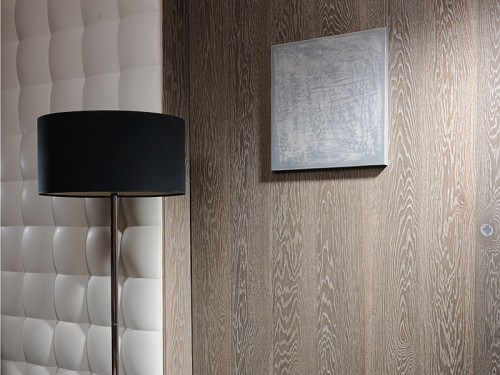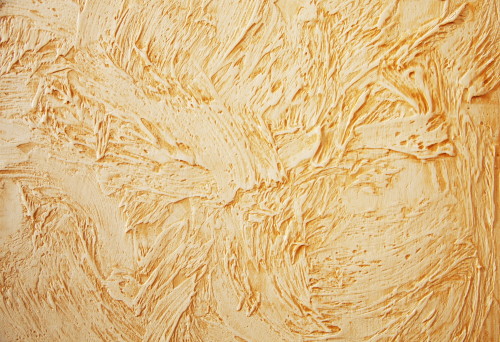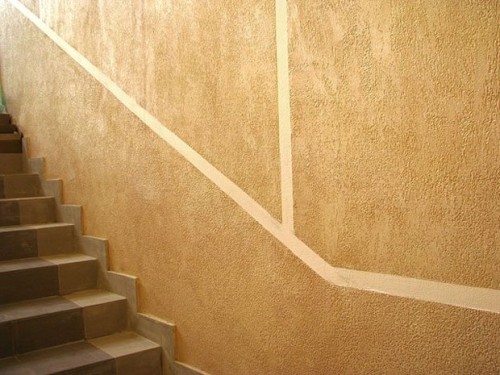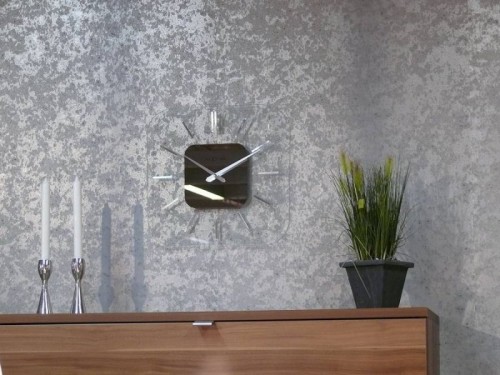A corridor, an entrance hall or a vestibule - one of the most passing places in the apartment. It is this room that meets and escorts housing visitors, and therefore the task of each owner is to make it beautiful and welcoming. The most visited zone in the house requires the appropriate finish so that it serves longer, without fear of pollution. It is also necessary to take into account that this room does not have a natural light, which imposes certain difficulties with its decor. The walls in the hallway should have as a lighter tone as possible so that the need for artificial lighting is not so sharp.
Content
- Glass finish
- Wall panels finish
- Decoration with decorative plaster
- Finishing with a microco -cement
- Decorative walls in the hallway of flexible stone
- Decorative stone for walls in the hallway
- Wall decoration in the hallway with wallpaper from traffic jams
- Decoration by quartz wallpaper
- Wall design in the hallway using metallized wallpaper
- Wall decoration in the hallway with liquid wallpaper
- Wall decoration in the hallway: photo
- Walls in the hallway options for decoration: video
How can the walls be finished in the hallway? The main requirement for materials for facing the corridor is strength and durability. The walls of this room should easily succumb to cleaning and updating, because they will constantly deal with dirt, dust and other contaminants that are inherent in the corridor. Now the choice of finishing materials is so great that, sometimes, it is difficult to make the right and optimal choice. Next, consider how to finish the walls in the hallway.
Glass finish
Modern glass wallpaper has very good “survivability”. Such textured material is used for painting. In combination with various colors, it can turn even the smallest corridor into a spacious room, adding it to the volume. This environmentally friendly material can withstand any effects, including pets. It is compatible with any type of paint and is absolutely resistant to the effect of the solvent. This quality allows wallpaper on the basis of fiberglass to withstand several dozen cycles of painting without losing the quality of the surface.
Also, the stronger side of this option is a relatively low price, which is suitable for absolutely everyone. For painting glass wallpaper, especially persistent paint is used, it is better based on latex, which will allow them to wash them without damage to the surface in the future. Glass finish for a long time will retain the attractive appearance of the hallway, despite all the troubles.
Wall panels finish
This option has gained its popularity due to the fact that thanks to it you can easily and quickly correct all the irregularities of the wall. Wall panels are attached to a special frame, which is assembled from metal profiles or wooden strips. Thanks to a large number of colors, such materials will be able to create a unique interior of your corridor.
For finishing work, as a rule, the plastic and MDF panels are used. The first option is much cheaper. Plastic is almost the perfect material for decorating rooms with high cross -country ability. He is not afraid of pollution, minor mechanical damage, can be washed several hundred times with any detergents without any consequences. MDF panels, although they are much more expensive than plastic, but they have a much more spectacular look. An undoubted advantage of wall panels is that they can be mounted for a fairly short period of time without dusty repair work. Naturally, the installation of a metal frame and panels does not go into any comparison with the plaster of the walls. A beginner can also cope with such work.
Of the shortcomings of this method, it is worth highlighting that the panels occupy a lot of space, and in small apartments it is impractical to mount them.
Decoration with decorative plaster
A rather old way of wall decoration. It consists in applying a special plaster layer on a pre -leveled wall, with which the masters create interesting, most often abstract patterns. This material is very good and for a long time on the wall, is not afraid of pollution, is very easily washed. If desired, the owner can easily change the design of the room, simply painting the walls in a different color. The most common plastering options:
- Bark beetle - plaster in its composition lumps of a certain size. When applying the solution, they stretch on a spatula, and the surface acquires the texture of the tree, as if "damaged by small insects." That is why this type of plaster received a similar name.
- A fur coat is a special technique for applying plaster, in which it resembles a fur coat.
- Also known are the methods of applying Venetian plaster, the “lamb” technique and others.
The disadvantage of decorative plaster is that only professional finishes can apply it, because this material is not cheap and rather moody to prepare the mixture. Wrong proportions can simply ruin the solution.
Finishing with a microco -cement
This is a pretty new material that is somewhat similar to plaster. It is a polymer-cement mixture to which special dyes are added. Thanks to a set of polymer components, such a material is reliably attached to absolutely any coating, creating a monolithic structure. The strength of this material allows it to easily transfer mechanical loads without damage to the surface. Thanks to various compounds, the micro -cement can have a different surface from rough and matte, to absolutely smooth glossy.
The advantage of such a material is a relatively low price in comparison with the plaster, while in which the components of the cement surpasses it.
Decorative walls in the hallway of flexible stone
This is a relatively new material that recently appeared in construction stores. However, in a short period of time, he managed to gain popularity. This decoration looks and has the texture of a real stone, but its structure allows it to bend. Thanks to this, a flexible stone can be used to finish arches, columns and other uneven surfaces. The material is quite strong and does not require special care, it is perfectly washed, so it is great for the decoration of the hallway and corridors.
Decorative stone for walls in the hallway
Artificial stone is one of the most popular facing materials for passing rooms. This composite material completely simulates the appearance of natural stone, for example, granite, marble, onyx. However, due to the use of special additives, it is much stronger than its natural brothers. A relatively small weight allows you to fix this material on the walls without the use of special tools and compositions. Since the basis of this decoration is gypsum, it can be safely attributed to environmentally friendly. Artificial stone does not require special care, it is easily washed, racks to mechanical damage.
The disadvantages of wall decoration in the hallway can be safely attributed to its cost. As a rule, in order to make the repairs estimate cheaper, only part of the walls, which can be subject to damage, is finished with artificial stone.
Wall decoration in the hallway with wallpaper from traffic jams
It is worth saying that this is not the most durable, but very interesting material for finishing. Thanks to him, you can create an unusual and bright interior. The lightness and environmental friendliness of the traffic jam is great for the decoration of any room. Although this material is not quite durable, small scratches are practically not noticeable on it. Using this material, it is necessary to take into account that it “absorbs” a large amount of light, which is why it is necessary to think over additional light sources.
Decoration by quartz wallpaper
This finish option has similarly appeared relatively recently. The wallpaper is a paper or non -woven base on which a very thin layer of sand is applied. By spraying on the surface of the sand layer of various colors, a rather interesting pattern is created. Due to the fact that sand is a rather strong material, such wallpaper can withstand both children's pranks and a pet. They just wash them, they can even be vacuumed. Unlike simple wallpaper, quartz are fireproof. The sand repels the flame, preventing it from getting to the base, which in turn prevents the fire from spreading around the room. If desired, such wallpaper can be easily repainted with latex paint, upgrading the interior of your housing.
Wall design in the hallway using metallized wallpaper
Such material is most suitable for creating an interior in the Hi-Tech style. They are performed by applying thin foil on a paper base. The metal layer is covered with special paint, applying ornaments and tightening. Such a finish looks just gorgeous. In addition, it is very practical. Such wallpapers do not attract dust, easily wash and are not afraid of mechanical damage.
However, they are not deprived of their shortcomings. So, working with them is quite difficult. The slightest irregularity of the surface on which the wallpaper will be applied will be noticeable, because they have a perfectly smooth structure. It is also necessary to make sure that the wall on which the canvases will be glued to absorb moisture. After all, the wallpaper glue, which is bred with water, will not be able to correct it through the metal layer. When working with these wallpaper, you must carefully treat the wiring. Electricity should be disconnected in the room when gluing itself. It should also be made sure that the wiring does not have contact with the surface of the paintings, because it can perfectly tolerate electric current.
Wall decoration in the hallway with liquid wallpaper
This facing material is a dry mix made of silk and cellulose powders, as well as various binders. For application, the solution is diluted with water until a whole homogeneous mass is obtained. The work is carried out using a roller, spatula or spray gun. After drying such wallpaper, any paint can be applied to their surface, making the color of the walls in the hallway as you dreamed about. They will be able to withstand a large number of paints, so the interior can be periodically changed. Also, before applying such material, you can not make the wall perfectly even, because you can apply them with a layer of up to 10 mm. Damaged areas of liquid wallpaper are easily restored.



















